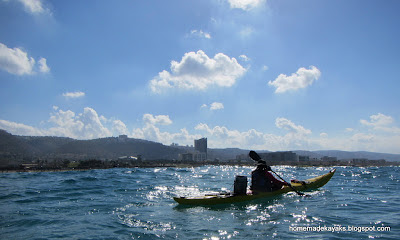Rescue practice takes up a big part of our symposium lessons and makes life interesting.
From the simple T rescue in quiet water, through self rescues and how to deal with a flooded kayak when all your hatches pop off and your kayak becomes a submarine. We had them all, and then ended the day with hauling our kayaks up on the rocks. We spent a lot of time in the water next to our boats and also paddled a bit with them full of water.Ben does not like to see anyone emptying out their cockpits with pumps or sponges, he reckons that we should all learn to paddle with a swamped boat, or at least with some water inside. Actually this makes a lot of sense because sometimes rescues in rough water does not allow you to drain your boat and you have to get in and paddle out to safer water as fast as you can, only then can you empty out the water. So if you have experience with paddling a swamped boat you don't feel threatened at all.
The last day we spent in the current learning how to deal with flowing water. Luckily for us , just down the beach there is the power station, they use seawater for cooling and have 2 outlets creating a nice safe playground for learning.
First of all we went up to look down on the water and Ben identified all the different conditions, like the hydraulics and hole as the water falls over the outlet, the rooster as the water rushes over a rock and the eddy line which is very clear to see from above.
Next we learned to spin our boats along the eddy line, useful for getting ready to cross or checking our line.
PAVES is the acronym , for crossing an eddy line, position, angle,vision,edge and speed, all taken into account when crossing.
Last of all we got to practice some rescues in moving water, and also had to retrieve a thrown water bottle in the current.
All in all a very active exciting fun day
Now its back to normal until next year.
in the current WMV V8 from
steve gordon on
Vimeo.





























































